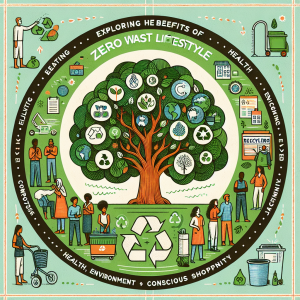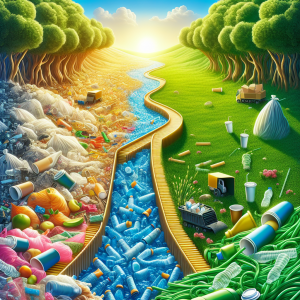Understanding Composting and Its Benefits
Composting is a natural process that transforms organic waste into nutrient-rich soil, known as compost. This process involves the natural decomposition of organic matter, aided by microorganisms, fungi, and insects. The main benefits of composting include reducing landfill waste, enhancing soil health, and mitigating climate change impacts by diminishing methane emissions from landfills. It’s also a cost-effective way to enrich soil for gardening, thus avoiding chemical fertilizers.
Types of Composting
1. Backyard Composting**** – Ideal for those with outdoor space, backyard composting involves collecting kitchen scraps and yard waste in a compost bin or pile. This method is flexible and can be adapted to the household’s needs, requiring regular turning and monitoring of moisture.
2. Vermicomposting**** – This method uses worms, typically red wigglers, to break down organic material. It’s perfect for small spaces, like an apartment, as it can be done indoors or in a small outdoor bin. Vermicomposting produces high-quality compost and worm tea, a liquid fertilizer.
3. Bokashi Composting**** – Originating from Japan, Bokashi uses anaerobic fermentation to decompose waste, allowing for a broader range of materials, like meat and dairy, to be composted. This method requires a special inoculated bran and airtight containers.
Essential Components for Successful Composting
1. Carbon-Rich Materials (Browns): These include dry leaves, straw, wood chips, and newspaper. Browns are essential for providing carbon for the composting process, crucial for balancing nitrogen-rich materials to minimize odors.
2. Nitrogen-Rich Materials (Greens): Greens consist of food scraps, grass clippings, and coffee grounds. These materials provide nitrogen necessary for microorganisms to decompose organic matter efficiently.
3. Airflow: Oxygen is vital for aerobic composting. Turning the pile regularly or using a well-aerated bin helps maintain airflow, reducing odor and speeding up decomposition.
4. Moisture: The ideal moisture level for composting is similar to a wrung-out sponge. Too much moisture can lead to anaerobic conditions, while too little slows down the process.
Instructions for Setting Up a Compost Bin
- Choose a Location: Select a dry, shady spot near a water source. Ensure it’s easily accessible but not in direct contact with any structure, to protect against pests and moisture damage.
- Select a Bin Type: Opt for a commercially available compost bin or a DIY model from materials like wood or wire mesh. Consider size and functionality for your specific needs.
- Layer the Materials: Start by layering browns and greens alternatively, beginning with coarse materials at the bottom for drainage. Aim for a ratio of roughly 3:1 browns to greens.
- Monitor the Compost: Turn the pile monthly to aerate and speed up decomposition. Keep it moist, especially during dry seasons.
- Harvesting: Compost is ready when it’s dark and crumbly, with no recognizable materials. This process may take from a few months to over a year depending on methods and conditions.
Common Issues and Troubleshooting
1. Odor Problems: Bad smells typically arise from too much nitrogen-rich material or lack of oxygen. Balance with more carbon materials and ensure regular turning.
2. Pests: Rodents and insects may be attracted to food waste. Avoid adding meat, dairy, or oily foods, and use a closed bin to deter access.
3. Sluggish Decomposition: Often caused by lack of nitrogen, moisture, or airflow. Boost the nitrogen component, maintain moisture levels, and turn regularly.
The Benefits of Organic Waste Recycling
Organic waste recycling not only contributes to composting but also supports broader environmental goals. When organic waste is recycled, it minimizes waste sent to landfills and the resultant methane emissions, which are potent greenhouse gases. This process transforms kitchen scraps, garden waste, and other organic materials into valuable resources, supporting circular economy principles.
Practical Tips for Successful Composting
- Avoid Adding Harmful Materials: Plastics, metals, and treated wood should never be composted, as they can introduce toxins.
- Compost Tea: This liquid fertilizer is made by soaking compost in water, providing a nutrient boost to plants.
- Seasonal Adjustments: During winter, heat retention is crucial—consider using a compost blanket or insulating the bin with straw.
- Involve the Family: Encouraging family participation can turn composting into an educational and fulfilling household activity.
Composting and Community Initiatives
Community composting programs are gaining traction, enabling individuals without personal composting capabilities to contribute their organic waste. These initiatives often convert significant quantities of waste into compost for community gardens, thus fostering local sustainability efforts. Engaging in or starting such programs can amplify the positive impact on environmental health.
Final Thoughts
Composting and organic waste recycling underline humanity’s ability to live in tandem with nature responsibly. By adopting these practices, beginners tap into environmental stewardship, reduce ecological footprints, and contribute to creating healthier, sustainable communities. This guide offers a foundational step, encouraging continuous learning and adaptation as one becomes more familiar with composting’s intricacies and benefits.




